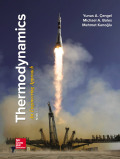
(a)
The equilibrium composition of product gases.
(a)
Answer to Problem 37P
Thus, the equilibrium composition of mixture of
Explanation of Solution
Write the expression for the volume of oxygen used per lbmol of carbon monoxide
Here, gas constant is R, temperature is T, and pressure is P.
Calculate the mass flow rate of carbon monoxide
Here, volume flow rate of carbon monoxide is
Calculate the molar air fuel ratio
Here, number of moles of oxygen is
Express the stoichiometric reaction for the dissociation process.
From the stoichiometric reaction, infer that the stoichiometric coefficient for carbon monoxide
Express the actual reaction for the dissociation process.
From the actual reaction, infer that the equilibrium composition contains x amount of carbon dioxide
Express the formula for total number of moles
Here, number of moles of carbon dioxide is
Write the expression for the equilibrium constant
Conclusion:
Substitute
Substitute
Substitute
Substitute xfor
Convert the temperature unit from Rankine to Kelvin.
Refer table A-28, “natural logarithm of equilibrium constants”, select the value of
Substitute
Solve the equation and find the value of x as 0.9966.
Substitute 0.9966 for x in Equation (V).
Thus, the equilibrium composition of mixture of
(b)
The rate of heat transfer from the combustion chamber
(b)
Answer to Problem 37P
The rate of heat transfer from the combustion chamber is
Explanation of Solution
Write the expression for the energy balance equation for the combustion process.
Here, heat released during combustion is
Write the expression for the mass flow rate of CO
Write the expression for the rate of heat transfer
Conclusion:
Refer Table A-26, “Enthalpy of formation, Gibbs function of formation, and absolute entropy at
778F, 1 atm”, select the enthalpy of
Refer Table A-21, “Ideal-gas properties of carbon monoxide”, obtain the following properties of
Enthalpy of
Enthalpy of
Enthalpy of
Use interpolation to get the Enthalpy of water vapor at 3600 K
Here, Enthalpy of
Substitute
Refer Table A-26, “Enthalpy of formation, Gibbs function of formation, and absolute entropy at
778F, 1 atm”, select the enthalpy of
Refer Table A-20, ‘Ideal gas properties of carbon dioxide’ find out the following enthalpies at different temperature.
Enthalpy of
Enthalpy of
Enthalpy of
Similarly, use interpolation and obtain the enthalpy of
Refer Table A-26, “Enthalpy of formation, Gibbs function of formation, and absolute entropy at
778F, 1 atm”, select the enthalpy of
Refer Table A-19, ‘Ideal gas properties of oxygen’, choose the enthalpy at the following temperatures.
Enthalpy of
Enthalpy of
Enthalpy of
Similarly, use interpolation and obtain the enthalpy of
Substitute
Substitute
Substitute
Thus, the rate of heat transfer is
Want to see more full solutions like this?
Chapter 16 Solutions
EBK THERMODYNAMICS: AN ENGINEERING APPR
- I need handwritten solution with sketches for eacharrow_forwardGiven answers to be: i) 14.65 kN; 6.16 kN; 8.46 kN ii) 8.63 kN; 9.88 kN iii) Bearing 6315 for B1 & B2, or Bearing 6215 for B1arrow_forward(b) A steel 'hot rolled structural hollow section' column of length 5.75 m, has the cross-section shown in Figure Q.5(b) and supports a load of 750 kN. During service, it is subjected to axial compression loading where one end of the column is effectively restrained in position and direction (fixed) and the other is effectively held in position but not in direction (pinned). i) Given that the steel has a design strength of 275 MN/m², determine the load factor for the structural member based upon the BS5950 design approach using Datasheet Q.5(b). [11] ii) Determine the axial load that can be supported by the column using the Rankine-Gordon formula, given that the yield strength of the material is 280 MN/m² and the constant *a* is 1/30000. [6] 300 600 2-300 mm wide x 5 mm thick plates. Figure Q.5(b) L=5.75m Pinned Fixedarrow_forward
- Q1: For the following force system, find the moments with respect to axes x, y, and zarrow_forwardQ10) Body A weighs 600 lb contact with smooth surfaces at D and E. Determine the tension in the cord and the forces acting on C on member BD, also calculate the reaction at B and F. Cable 6' 3' wwwarrow_forwardHelp ارجو مساعدتي في حل هذا السؤالarrow_forward
- Q3: Find the resultant of the force system.arrow_forwardQuestion 1 A three-blade propeller of a diameter of 2 m has an activity factor AF of 200 and its ratio of static thrust coefficient to static torque coefficient is 10. The propeller's integrated lift coefficient is 0.3.arrow_forward(L=6847 mm, q = 5331 N/mm, M = 1408549 N.mm, and El = 8.6 x 1014 N. mm²) X A ΕΙ B L Y Marrow_forward
 Elements Of ElectromagneticsMechanical EngineeringISBN:9780190698614Author:Sadiku, Matthew N. O.Publisher:Oxford University Press
Elements Of ElectromagneticsMechanical EngineeringISBN:9780190698614Author:Sadiku, Matthew N. O.Publisher:Oxford University Press Mechanics of Materials (10th Edition)Mechanical EngineeringISBN:9780134319650Author:Russell C. HibbelerPublisher:PEARSON
Mechanics of Materials (10th Edition)Mechanical EngineeringISBN:9780134319650Author:Russell C. HibbelerPublisher:PEARSON Thermodynamics: An Engineering ApproachMechanical EngineeringISBN:9781259822674Author:Yunus A. Cengel Dr., Michael A. BolesPublisher:McGraw-Hill Education
Thermodynamics: An Engineering ApproachMechanical EngineeringISBN:9781259822674Author:Yunus A. Cengel Dr., Michael A. BolesPublisher:McGraw-Hill Education Control Systems EngineeringMechanical EngineeringISBN:9781118170519Author:Norman S. NisePublisher:WILEY
Control Systems EngineeringMechanical EngineeringISBN:9781118170519Author:Norman S. NisePublisher:WILEY Mechanics of Materials (MindTap Course List)Mechanical EngineeringISBN:9781337093347Author:Barry J. Goodno, James M. GerePublisher:Cengage Learning
Mechanics of Materials (MindTap Course List)Mechanical EngineeringISBN:9781337093347Author:Barry J. Goodno, James M. GerePublisher:Cengage Learning Engineering Mechanics: StaticsMechanical EngineeringISBN:9781118807330Author:James L. Meriam, L. G. Kraige, J. N. BoltonPublisher:WILEY
Engineering Mechanics: StaticsMechanical EngineeringISBN:9781118807330Author:James L. Meriam, L. G. Kraige, J. N. BoltonPublisher:WILEY





